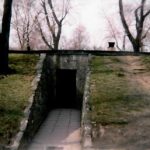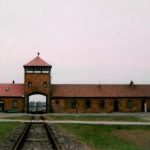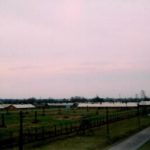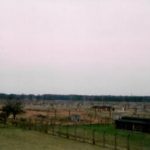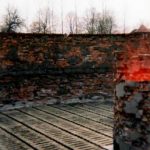
Beyond the Black Gates
I shivered in the thick army fatigue jacket as I stood beneath a motto wrought in the same black iron as the gates that held it: “Arbeit Macht Frei” (Work Brings Freedom). It was the entrance to KL Auschwitz I, the concentration camp that spawned forty more like it including the massive Birkenau. Concentration camps. Work camps. Death camps.
In March of 1994, I hiked through central and eastern Europe. An American student abroad, I toured ancient castles and battlefields, museums and art galleries. I stood before the gates of KL Auschwitz I and did not know what to think. It was a death camp; I felt embarrassed thinking of myself as a tourist at another attraction. I was not even sure what I was doing there.
The previous night, at the urging of a group of travelers from the hostel I was staying at, I sat with the people of Krakow, Poland to watch the premiere of Schindler’s List. I had learned enough about the holocaust in high-school classes to know that I had learned enough. I am Catholic, raised in a Catholic neighborhood and taught at Catholic schools. The way I was raised, and taught, the holocaust, Schindler’s List, and Auschwitz were part of Jewish history. The Holocaust was part of Jewish History; something that happened to “them.”
In the theater, I felt like a voyeur as I studied the people of Krakow watching a movie about their intimate history. I watched them as they watched the movie. Tears being rubbed away. Unblinking eyes. Hands gripped tightly on seat handles and loved ones—and strangers. Most Poles are Catholic; when I graduated high-school in 1989, there were more people in my high-school than there were Jews in Poland. The people in the theater, including the Protestant British girl and Catholic French guy I had gone to the salt mines with, watched the movie with a quiet intensity. In the huge theater, easily four times the size of anything back in the States, nobody had moved throughout the entire 3 ½ hour film—even the people who sat in the aisles and those who craned their necks to look up at the screen directly in front of them. The slow exodus when the last of the credits had faded away, and the hushed reverent tones of the conversations around me, made me begin to wonder if Auschwitz was also a part of my history.
I toyed with the butt of another cigarette, the third in ten minutes since I had left the welcome center where various literature was displayed and tour groups gathered. I straightened my shoulders, opened the guide book, and began to read the history that Steven Spielberg tried to imitate as I walked into KL Auschwitz I.
The State Museum in Oswiecim
Auschwitz is actually the German name of a geographical area in Poland that it annexed after the September Campaign in 1939. KL Auschwitz I, the first concentration camp in the area, was built in 1940 near the town of Oswiecim, outside of Krakow, at the sight of an old Polish army barracks. Though originally built to deal with Polish political prisoners, it would later be modified with the addition of a crematorium and gas chamber to effect the extermination of political prisoners, Jews, Gypsies, and the citizens and soldiers of conquered countries.
With the barbed wire behind me, I crunched down a broad gravel strewn path between red-brick buildings discolored with age. A stiff breeze swirled leaves around statuesque trees that stretched slender limbs towards the sky. Shafts of sunlight pierced through the cloud cover to reflect off of slate roofs. My first thoughts past the gate were of a New England college town. Then, I reached the first main intersection and glanced to my left.
At odds with the picturesque scene was a squat, ugly building with utilitarian walls blackened by smoke. A rusted metal door hung open and a thick smokestack jutted into the sky. The guidebook said it was supposed to be the last stage of the tour, but I wanted to see the crematorium and gas chamber first. Standing like a sentry before the entrance was the only resembling justice I would see during the entire tour: a black wood gallows built at the end of the war to hang Rudolf Hoss, the first commandant, for crimes against humanity.
There is a scene in Schindler’s List where people are being herded into a building much like the one in front of me. They are smiling, laughing, and talking among amongst themselves. To control the crowd, the German soldiers had explained to the people that they were going to take a shower. In some of the gas chambers, shower heads had even been installed, but they had never been connected to a water source. Men, women, and children would be stripped, their heads shaved, and then their bodies crowded into a chamber with iron doors. From special holes in the ceiling, soldiers would pour Cyclon B into the chamber. It took 15 to 20 minutes for the people to die.
The room I entered was not built to deceive prisoners. Chutes ran straight to the retorts of a large oven with pitted doors. The walls and equipment were stained with the thick black smoke that had escaped from the ovens. I was never sure if the acrid smell that hung in the air was still there after more than 40 years or if it was something I imagined. I touched the bronze panel welded onto the side of the oven. It was emblazoned with the name of the firm that had built much of the equipment for this building, and many buildings like it: Toph und Sohne from Erfurt. A grotesque image came to mind of a twisted Henry Ford turning his innovation of mass assembly lines towards the extermination of a race.
The Blocks
A tour group went into the first building, or “block,” on the tour. I did not want to be a part of the crush of people roaming through the building so I waited outside and smoked a cigarette. A couple of other people waited with me, I guess for the same reason I waited. Nobody in our group of four made eye contact or tried to make conversation. When the large tour group exited, we passed through the wood and glass doors into a dimly lit hallway. The greenish paint was rough to the touch and covered a gritty wall surface, much like that of any WWII era home in the United States. My companions and I separated, leaving each other alone to wander the rooms of the concentration camp
Each building, and each room, is a different exhibit. KL Auschwitz I was given back to Poland after World War II and renamed the State Museum of Oswiecim. Retreating SS troops had tried to destroy records and other signs of their guilt including the crematorium and gas chamber, but between what was left, and recovered plans, historians were able to rebuild the crematoria and gas chamber using the original materials. [this sent is a bit awk—maybe trim for clarity?] Documents and photographs that had been smuggled out of the camp at a huge risk flooded back to the concentration camp turned museum. Ex-prisoners returned to share their stories. Each room became a testimonial of those who suffered and died at the hands of the Nazis.
Days could be spent in each room: looking at the photographs, reading through the translated materials that told the gruesome stories, gazing at the paintings by ex-prisoner-artists that depict routine days in the camp, and honoring the rolls of names and pictures of those who suffered and died. There are blocks dedicated to the people from particular countries so that their own histories can be read: where they were taken from, an estimate of a number, and private shrines built and maintained by their relatives and countrymen. In some rooms are pictures taken by SS men and their private written accounts like that of the photographic and written journal I was keeping of my European tour. I am not sure how long I wandered through each room, touching the glass enclosures and wrapped in the musty air; as someone from my party entered the room I was in, I would leave to explore another testimonial in solitary silence.
In Schindler’s List, and in documentaries I have seen on the holocaust, a common scene is one of vast funeral pyres. The Nazis burned not only those they killed, but also the bodies that they had the prisoners dig up from Jewish cemeteries. Hitler’s plan extended beyond the extermination of the Jewish race; he sought to obliterate all traces that the Jews ever existed. To commemorate the estimated 1.5 million incinerated bodies, the first room of the tour contains an urn that holds a handful of ashes. It is the summation of all that is about to be seen.
Two exhibits struck me more than any of the others. The difference between Steven Spielberg’s film and the exhibits is like the difference between a hammer and a wrecking ball. In the beginning of the movie, Jews are hunted through the ghetto in Krakow, a scene that was repeated time and time again throughout the war. Mountains of personal belongings dotted the ghettos until they could be transported to collection points. Prisoners entering the camps would be stripped and even their basic items like toothbrushes and eye glasses would be taken from them. The possessions would be sent back to Germany to be used by their population. I could not imagine the immensity of the operation until I entered block 5. Each room was separated by clear plastic into sealed compartments the size of six Volvos, two deep and three wide. Each compartment was filled chest high with particular items that had been found stacked in warehouses after liberation: an entire compartment filled with toothbrushes, pairs of shoes, artificial limbs, eye glasses, and human hair. And these were just small portions of what was found. It was reported that the Soviet troops that liberated Auschwitz found one warehouse filled with seven tons of human hair.
Block 6, room 4, shows something that Schindler’s List was unable to depict. Throughout the movie, prisoners are shown naked to reveal well-fleshed to emaciated bodies. It was impossible to show the truth that pictures in this room displayed. There are photographs, taken immediately after liberation, of women prisoners weighing 50-65 pounds. They were skeletal, with their bones clearly countable. Hard labor was a part of each day, 12 hours or more. The calories in a day’s food ration amounted to that contained in a gallon of skim milk.
The Heart of Auschwitz’s Horror
I began to see the buildings in a different way. The facade of a New England college dormitory was still there, but now I knew that the trees had been planted following liberation. The red-brick buildings were discolored not only with age, but with smoke, blood, and the acidic sweat of fear. I joined with my small group to enter the last two blocks; by unspoken agreement, we did not separate as we had before. Farthest away from the entrance, the two blocks were the heart of what Auschwitz had been.
The first of the two blocks were like any of the others, except for the sinister history revealed to us in plaques, signs, and our guidebooks. It had been the camp hospital, though “hospital” was the most inappropriate of terms– the prisoners had called the block “the anteroom of the crematoria.” From here, SS doctors would issue forth to inspect the camp prisoners and prevent overcrowding. They would separate the strong from the weak, the sick from the most sick, and send the worst straight to the gas chambers. The patients that were brought to them that did not have a good chance of a quick recovery were given an injection of phenol to the heart. Worst of all was the basement, the laboratories, where infamous doctors such as C. Clauberg and Joseph Mengele performed experiments on the prisoners: developing ways to sterilize women, testing the harmful effects of chemicals by applying them to prisoners’ skin, and performing genetic and anthropological research. Twins and handicapped prisoners were most important for the research; they were sent straight to the hospital.
Between blocks 10 and 11 was a walled enclosure where between every other building there had been an open square. To the left, block 10, all of the windows facing the courtyard were shuttered, the only shutters to be found in the camp. To the right, block 11, there were doors that opened onto the yard. I stood in the middle and space seemed to compress: the overhead clouds became a ceiling and the air was thicker with no trace of the prevalent breeze. At the far end of the yard is a wall, simply called “The Wall of Death.” It was where the political and special prisoners housed in block 11 were executed by firing squad.
Like a man slowing down his car to view an accident, I approached the wall and reached out to feel to the rough bumpy surface. I turned. Time slowed. Dirt underneath bare feet, sweating naked bodies next to me, the only sight the stairs I had been led from and the wall at the far end, surrounded by screams coming from the two blocks. Staring down the rifle of a soldier.
I pushed myself away from the wall and exited the open arch, a post-war addition to the camp.
My group entered block 11, “Death Block.” Wandering through this prison within a prison, I realized what creeping emotion I had almost felt when I stood with my back to the wall: comfort. Death at the wall, by a marksman’s bullet, was the cleanest death in the camp. It was in block 11 that they built the first experimental gas chamber. 600 Soviet POWs and 250 sick prisoners were the first to die that way. There were also rooms for special executions: an empty room with thick metal bars to murder by starvation and an airtight chamber to execute through suffocation. Block 11 was also for special punishments.
The final room I was to see at KL Auschwitz I was for special punishment. In the smallest room in the building, there were four cinderblock cubicles, each one a square yard in diameter and six feet high. At the bottom of each was a small metal grate, the only passages into the cubicles. Four prisoners at a time would be pushed into each cold coffin-like interior to stand for days, or weeks.
As I passed through the barbed wire gate with its cynical motto, a British girl remarked that the ghosts of those who died must surely haunt this place at night. I remember thinking it unlikely, since those who died would not want to inhabit this place anymore. The only hauntings would be those like myself who would be haunted by screams that had been silent for more than four decades.
Birkenau
“Birkenau is not like Auschwitz,” I was told by the cab driver who agreed to drive me the two miles to the second concentration camp. “Auschwitz is where the…tourists go. Birkenau is different. Many who go there wish that they had gone back to Krakow after leaving Auschwitz.”
From Schindler’s List, I remembered train tracks that ran into the camp. The train tracks were what set my mind to go to Birkenau. There had not been any at KL Auschwitz I. It was the only tangible thing that I could grasp.
Birkenau, originally named KL Auschwitz II, was built in 1941 near the town of Brzezinka. Where KL Auschwitz I had been originally intended for political prisoners and had to be expanded to serve as a death camp, Birkenau had been built for one purpose: the extermination of all Jews.
After a quick conversation in broken Polish-English, the cab driver let me off on the train tracks 200 yards from the front gate. A massive building stood in front of me, stretched out to encompass the horizon. In the middle was the main SS guard tower, twice as tall as the rest of the building. The tracks led straight to the tower and into a gaping maw that ran through the tower and into Birkenau. Twin black iron gates that could be opened to allow the trains to pass through were called simply “Death Gate.”
There are no formal tours at Birkenau. There is only a map with red arrows pointing to the best route to take through the concentration camp. The first stop is the top of the main guard tower. I gazed out over the camp while I listened to the recorded commentary about the place. If the main building sought to encompass the horizon, Birkenau was the horizon. It was vast, 425 acres, about the size of the town of Pinecrest. Where KL Auschwitz could hold a maximum of 20,000 prisoners, Birkenau held as many 100,000 at one time, more than the capacity of Joe Robby Stadium. All the prisoners, separated by sex and nationality, waited for death.
I followed the train tracks that split the camp into two halves until I was at the main unloading area. This was the place from the movie where Schindler’s female Jews were taken accidentally. Unloaded from packed cars, the prisoners were then herded to their particular section of the camp and crammed into squalid quarters.
I trekked through a desolate landscape. Crumbling piles of stone and rotting wood were all that remained of barracks that had been either blown up by retreating SS troops or torn down by prisoners after their liberation. Weeds fought for space with broken glass and rubble along the sides of those buildings that had been left standing. It was completely quiet except for the sound of the wind moaning through buildings. I could not imagine people here, living, working, dying.
The barracks were just as desolate but for some reason it was not hard for me to imagine them crowded as I ran my fingers down the rough wood planks that made the bunks. Jew and Catholic, Gypsy and Soviet POW, Czech, Hungarian, Jehovah Witness, and homosexual all were stuffed into the barracks, sometimes eight to a bunk, three bunks on one wall. With only rotting straw and threadbare prison “stripes” for clothing, eight to a bunk would seem comforting in the winter time, the only warmth they would know except for the heat of the crematoria and funeral pyres. Spring and summer would come, though. The dirt floors would churn with mud and unbathed bodies would reek with the diseases that ran rampant : typhus, typhoid fever, scabies. And throughout everything, the appalling stench of burning flesh.
Each building that I walked through was exactly the same until I came to one that had a mural painted on a wall. A plaque by the mural read that it was originally painted by prisoners during the time of occupation. Even though it was small, about the size of a 20 inch television, I could not imagine how the prisoners had kept it hidden from the guards. Moments after I left Birkenau, to this day, I cannot recall what the mural was. I only remember the colors, and wonder how the colors were created: blood for red, crushed grass for green, but what about the blues? and yellows? And the soft purple?
Factory of Death
Like at KL Auschwitz I, retreating SS troops tried to cover their crimes by blowing up their instruments of death. In Birkenau, that was impossible. Five crematoria still stand open to the sky. The guidebook read that the crematorium at KL Auschwitz I could incinerate 350 bodies daily. The entire squat building, crematorium, gas chamber, and changing room, could fit into one of Birkenau’s crematoria. Each hole is like a gaping wound in the ground, with fire blackened walls and pitted metal grates used to push the bodies over. Underneath them were the changing rooms and gas chambers specially designed by a German engineering firm to murder the estimated 1.5 million men, women, and children.
I climbed around rubble and into the holes, unable to think or feel. The immensity of the holocaust, seen here, was just too overpowering for me to process. I walked back and forth across the crematorium trying to estimate how many could be burned at one time. I examined the metal grates and the rivulets underneath to figure out their purpose. I inspected the walls, without touching them, to see if I could find any traces of those who had passed before me. I could not find what I was looking for.
As creative as I am, and as many books as I have read, I still cannot find the words to label my thoughts. Monstrous. Immense. Massive. Each word a poor one. Standing within the crematoria was like standing before a vast tidal wave right before it is about to break. All sight is wiped out. The pressure of the air increased to the point of physical pain. Before you, an incalculable amount of water, a torrent of emotion.
The Last Few Steps
I emerged from underneath the tidal wave, or rather just pushed it to an inner recess of my mind, and stood before the only addition to Birkenau since it was liberated. At the end of the railroad tracks, on the far side of the camp, a monument was erected in April 1967: the International Memorial to the Victims of Fascism. It has a cobblestone base that extends for meters in every direction. Chiseled stone, in various shapes, mark the center of it. Through the middle of the monument are raised stones, inset with metal script and symbols. Each day, a fresh flower is placed upon each one. It is a place to be stared at or wept over. For myself, the embodied testimonial of the two camps is a monument in and of itself. Never to be forgotten.
During the last stage of my journey, I found a much more fitting monument than the one of stone and metal. On the other side of Birkenau from the crematoria lies a lake—more like a pond—where the ashes carried from the crematoria had been dumped. The ground surrounding the lake is sooty, the water muddied. Along the edges, there is a sandy lip and waist high rushes. Like the urn that sits in KL Auschwitz I, it holds the knowledge of the estimated 1.5 million deaths.
I stared into the lake for a quiet moment. The wind had died for the first time that day though the sky remained overcast. In the stillness, I turned to leave. A movement caught my eye. I turned back and saw a tiny frog making its way along the sandy lip of the lake. I smiled, a small smile, the first one since seeing Schindler’s List the night before. When I later recounted the story of the frog to a friend of mine, he suggested that if ever I write the story, to use a white bird instead of the frog for a more symbolic effect. I choose not to; the frog is enough.
When I left Krakow the following day, I left with a new part to my history. Schindler’s List, the holocaust, and Auschwitz became something more than a Jewish thing, and at the same time something larger than a Jewish thing. It became part of my history as a human being. Besides the fact that the lists of dead in Nazi concentration camps includes Soviets, Poles, Gypsies, Slavs and other people that were non-Jewish, every person that died, every man, woman, and child, was a human being. The monuments, both the one of metal and stone and the lake of ashes, were not memorials to Jews, but to victims of Fascism.
- A New England town?
- Down to the gas chamber
- The wall
- View from the Wall
- The Heart of horror



